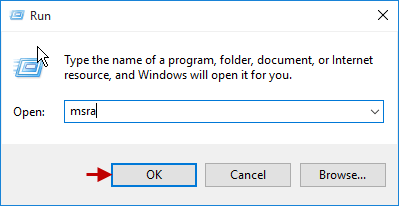Specifies the Remote Assistance Protocol, which is usedafter a remote assistance connection is established between two computers.
Oracle Enterprise Single Sign-On Suite Plus - Version 11.1.2.3.1 and later: Microsoft Remote Assistance Tool (msra.exe) Fails On Windows 10 1903+ With ESSO Logon Man.

You can use the Remote Desktop Connection (mstsc.exe) or Microsoft Remote Desktop app to connect to and control your Windows 10 PC from a remote device. When you allow remote desktop connections to your PC, you can use another device to connect to your PC and have access to all of your apps, files, and network resources as if you were sitting. Allow Remote Assistance to this computer. Open Remote Assistant, to open: Type Msra in the windows search box and click on it. Open Remote Assistant. Click on Invite someone you trust to help.
This page and associated content may beupdated frequently. We recommend you subscribe to the RSSfeed to receive update notifications.
Published Version
Date | Protocol Revision | Revision Class | Downloads |
|---|---|---|---|
4/7/2021 | 15.0 | Major | PDF | DOCX | Diff |
Previous Versions
Date | Protocol Revision | Revision Class | Downloads |
|---|---|---|---|
9/12/2018 | 14.0 | Major | PDF | DOCX | Diff |
12/1/2017 | 13.0 | None | PDF | DOCX | Diff |
9/15/2017 | 13.0 | Major | PDF | DOCX | Diff |
6/1/2017 | 12.0 | None | PDF | DOCX | Diff |
7/14/2016 | 12.0 | None | PDF | DOCX | Diff |
10/16/2015 | 12.0 | None | PDF | DOCX |
6/30/2015 | 12.0 | Major | PDF | DOCX |
5/15/2014 | 11.0 | None | PDF | DOCX |
2/13/2014 | 11.0 | None | PDF | DOCX |
11/14/2013 | 11.0 | None | PDF | DOCX |
8/8/2013 | 11.0 | Major | PDF | DOCX |
1/31/2013 | 10.2 | None | |
10/25/2012 | 10.2 | None | |
7/12/2012 | 10.2 | Minor | |
3/30/2012 | 10.1 | Minor | |
12/16/2011 | 10.0 | Major | |
9/23/2011 | 9.1 | None | |
6/17/2011 | 9.1 | Minor | |
5/6/2011 | 9.0.1 | None | |
3/25/2011 | 9.0.1 | None | |
2/11/2011 | 9.0.1 | None | |
1/7/2011 | 9.0.1 | None | |
11/19/2010 | 9.0.1 | None | |
10/8/2010 | 9.0.1 | None | |
8/27/2010 | 9.0.1 | None | |
7/16/2010 | 9.0.1 | None | |
6/4/2010 | 9.0.1 | Editorial | |
4/23/2010 | 9.0 | Major | |
3/12/2010 | 8.0.1 | Editorial | |
1/29/2010 | 8.0 | Major | |
12/18/2009 | 7.0 | Major | |
11/6/2009 | 6.0 | Major | |
9/25/2009 | 5.2 | Minor | |
8/14/2009 | 5.1 | Minor | |
7/2/2009 | 5.0 | Major | |
5/22/2009 | 4.0 | Major | |
4/10/2009 | 3.0.3 | Editorial | |
2/27/2009 | 3.0.2 | Editorial | |
1/16/2009 | 3.0.1 | Editorial | |
12/5/2008 | 3.0 | Major | |
10/24/2008 | 2.0.3 | Editorial | |
8/29/2008 | 2.0.2 | Editorial | |
7/25/2008 | 2.0.1 | Editorial | |
6/20/2008 | 2.0 | Major | |
5/16/2008 | 1.4.3 | Editorial | |
3/14/2008 | 1.4.2 | Editorial | |
1/25/2008 | 1.4.1 | Editorial | |
11/30/2007 | 1.4 | Minor | |
10/23/2007 | 1.3.1 | Editorial | |
9/28/2007 | 1.3 | Minor | |
8/10/2007 | 1.2 | Minor | |
7/20/2007 | 1.1 | Minor | |
7/3/2007 | 1.0.1 | Editorial | |
6/1/2007 | 1.0 | Major | |
2/22/2007 | 0.01 | New |
Preview Versions
From time to time, Microsoft maypublish a preview, or pre-release, version of an Open Specifications technicaldocument for community review and feedback. To submit feedback for a previewversion of a technical document, please follow any instructions specified forthat document. If no instructions are indicated for the document, pleaseprovide feedback by using the Open Specification Forums.
The preview period for a technical document varies.Additionally, not every technical document will be published for preview.
A preview version of this document may beavailable on the WindowsProtocols - Preview Documents page. After the preview period, themost current version of the document is available on this page.
Development Resources
Findresources for creating interoperable solutions for Microsoft software,services, hardware, and non-Microsoft products:
Plugfestsand Events, Test Tools,DevelopmentSupport, and Open SpecificationsDev Center.
Intellectual Property Rights Notice for Open Specifications Documentation
Technical Documentation. Microsoft publishes OpenSpecifications documentation (“this documentation”) for protocols, fileformats, data portability, computer languages, and standards support.Additionally, overview documents cover inter-protocol relationships andinteractions.
Copyrights. This documentation is covered by Microsoftcopyrights. Regardless of any other terms that are contained in the terms ofuse for the Microsoft website that hosts this documentation, you can makecopies of it in order to develop implementations of the technologies that aredescribed in this documentation and can distribute portions of it in yourimplementations that use these technologies or in your documentation asnecessary to properly document the implementation. You can also distribute inyour implementation, with or without modification, any schemas, IDLs, or codesamples that are included in the documentation. This permission also applies toany documents that are referenced in the Open Specifications documentation.
No Trade Secrets. Microsoft does not claim any tradesecret rights in this documentation.
Patents. Microsoft has patents that might cover yourimplementations of the technologies described in the Open Specificationsdocumentation. Neither this notice nor Microsoft's delivery of thisdocumentation grants any licenses under those patents or any other Microsoftpatents. However, a given Open Specifications document might be covered by theMicrosoft Open Specifications Promiseor the Microsoft CommunityPromise. If you would prefer a written license, or if thetechnologies described in this documentation are not covered by the OpenSpecifications Promise or Community Promise, as applicable, patent licenses areavailable by contacting iplg@microsoft.com.
License Programs. To see all of the protocols in scopeunder a specific license program and the associated patents, visit the Patent Map.
Trademarks. The names of companies and products containedin this documentation might be covered by trademarks or similar intellectualproperty rights. This notice does not grant any licenses under those rights.For a list of Microsoft trademarks, visit www.microsoft.com/trademarks.
Fictitious Names. The example companies, organizations,products, domain names, email addresses, logos, people, places, and events thatare depicted in this documentation are fictitious. No association with any realcompany, organization, product, domain name, email address, logo, person,place, or event is intended or should be inferred.
Reservation of Rights. All otherrights are reserved, and this notice does not grant any rights other than asspecifically described above, whether by implication, estoppel, or otherwise.
Tools.The Open Specifications documentation does not require the use of Microsoftprogramming tools or programming environments in order for you to develop animplementation. If you have access to Microsoft programming tools andenvironments, you are free to take advantage of them. Certain OpenSpecifications documents are intended for use in conjunction with publiclyavailable standards specifications and network programming art and, as such,assume that the reader either is familiar with the aforementioned material orhas immediate access to it.
Support.For questions and support, please contact dochelp@microsoft.com.
Quick Assist is a new app in Windows 10 that enables you to receive or provide assistance over a remote connection. We encourage you to try Quick Assist for a more streamlined, easy-to-use experience.

Open Quick Assist
Microsoft Msra Tool

Select Start > Quick Assist.
Give assistance
Select Start > Quick Assist (or select the Start button, type Quick Assist in the search box, then select it in the results). Select Assist another person, then send the 6-digit code to the person you're helping. When they've entered it, select either Take full control or View screen. Select Continue and wait for the person you're helping to allow the connection.
Get assistance
Microsoft Remote Access Port
Select Start > Quick Assist (or select the Start button, type Quick Assist in the search box, then select it in the results). In the Code from assistant box, enter the 6-digit code you were given, and select Share sceen. Wait for your helper, then select Allow in the window that displays.
You can also use Windows Remote Assistance and Easy Connect to give and receive remote assistance.

 -->
-->